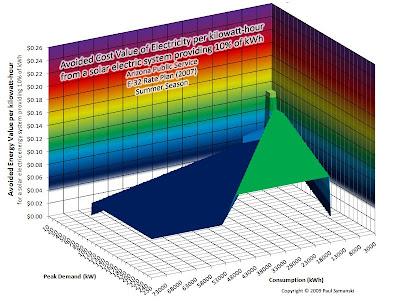If electricity from the grid was free, then an investment in on-site solar electricity generation would have little economic value. Because energy comes from the grid at great apparent and hidden costs, solar electricity has extraordinary value. However, the economic value of solar electricity generated on-site is determined by the retail cost of the least expensive competing energy whose purchase can be avoided. The economic value of solar electricity is not necessarily determined by the price you pay for electricity under your currently subscribed rate plan. Rather, it is determined by the plan with the least expensive energy for your consumption pattern from all the rate plans available in the market for your sector and for which you are qualified to subscribe. This is true for an investment in any energy management strategy.
For any particular rate plan, the avoided cost value of solar electricity can be visualized, just as can be the average monthly retail cost of electricity. Here is the average monthly retail cost of electricity per kilowatt-hour for commercial ratepayers under the Arizona Public Service (APS) E-32 commercial rate plan:

Here is the average monthly avoided cost value per kilowatt-hour under the Arizona Public Service (APS) E-32 commercial rate plan for electricity generated on-site by a solar electric energy system providing 10% of kilowatt-hours consumed:

The key observation – and the linchpin of the Rate Crimes exposé – is that the avoided cost value of solar electricity and other energy management strategies has long been dramatically lower than the retail cost of electricity under particular rate plans.
Combining the two visualizations above into a ratio of avoided cost to retail energy cost produces this visualization:

The avoided cost value of solar electricity is half that of the retail cost of electricity for a great portion primarily because of the uncontrollable billing demand, and a precipitous declining block rate structure compounded by the uncontrollable billing demand being used as a multiplier for the extents of the expensive initial block.






Solar energy is the best natural resource that we have this time even more that fuel is too expensive. In fact i want to approach costa rica investment opportunities and look all the alternative this country can have because it climate. We must to find the way to save our planet and to use solar energy could be the first step.
ReplyDeletewhy does the average cost fall at low consumption rates?
ReplyDeletecan you make this into a more digestable PPT?
Joe said, "why does the average cost fall at low consumption rates?"
ReplyDeleteThat's a good question, but difficult to answer without getting into the minds of the APS analysts and executives; or, at least, getting the consumption data they use to shape their rate schedules.
As for presenting this data in other forms: I did that many times over the years for too little compensation. The current rate schedules are published, but it is difficult to find the historical schedules. For me, it is the history of repression that is most offensive.
My question is simpler than you suspect. I'd like to repeat the analysis. Did you combine the E-32 Commercial rates for all business sizes onto one graph? Or did you use only one of the rates.
ReplyDeleteCurrently I see 4 separate E-32 rates, plus flat or TOU rates for each of the 4.
The analyses are performed each for a single, published rate plan. You will see the date of the analysis on its 3D graph.
ReplyDeleteThe rate schedules have been changed many times over the years.